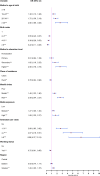Dominant predictors of postnatal care utilization among ever-married mothers of reproductive age in Bangladesh
- PMID: 40287627
- PMCID: PMC12032723
- DOI: 10.1186/s12884-025-07591-3
Dominant predictors of postnatal care utilization among ever-married mothers of reproductive age in Bangladesh
Abstract
The majority of maternal mortality occurs during the postpartum period worldwide. Therefore, postnatal care (PNC) is crucial for both mother's and newborn's survival. Unfortunately, PNC is underutilized in Bangladesh and well below any admissible level. The purpose of this study is not only to identify the potential factors associated with PNC but also to explore the more intriguing aspect of finding the most important determinants of PNC receipt among mothers in Bangladesh. Binary logistic regression analysis was employed to determine the factors associated with PNC receipt using data from the Bangladesh Demographic and Health Survey (BDHS) 2017-18. The BDHS 2017-18 utilized a two-stage stratified sampling method, selecting 675 enumeration areas (EAs) in the first stage with probability proportional to size and then choosing a systematic sample of 30 households from each EA in the second stage. The analysis considered mothers with a most recent child under three years of age at the time of the survey, leading to a total of 4899 women. The response variable of interest is the receipt of PNC from a medically trained provider (MTP) within two days of delivery. It is observed that 52.8% of mothers received PNC from MTP within two days of childbirth. The variables mother's age at birth, birth order, mother's education level, place of residence, wealth index, media exposure, antenatal care (ANC) visits, working status, and region are all found to be significantly associated with PNC seeking behavior. General dominance (GD) analysis was employed to assess variable importance because complete, and conditional dominances rarely occur. GD is the simplest among the three dominances and can be computed without computing the other two by using a simpler subset model structure. Considering the two-stage stratified sampling design, the analysis reveals that ANC visits, family wealth status, and the mother's education level were the three most dominant predictors of PNC visits, explaining approximately 68% of the total variance. The results suggest that policymakers and stakeholders should intensify the existing facilities to increase awareness of taking ANC visits, which would eventually encourage women to take PNC. Additionally, efforts should be made to help economically disadvantaged women overcome the barriers that prevent them from accessing maternal health care. Finally, the government of Bangladesh should stimulate women to complete at least their secondary education.
Keywords: Bangladesh; Dominance analysis; Postnatal care; Postpartum women.
© 2025. The Author(s).
Conflict of interest statement
Declarations. Ethics approval and consent to participate: No ethics approval was required as this study used anonymized data from BDHS 2017-18. A signed written consent about the survey was read and given to every respondent before the interview. We have obtained permission from MEASURE DHS to access and analyze BDHS 2017-18 dataset. Consent for publication: Not applicable. Competing interests: The authors declare no competing interests.
Figures
References
-
- WHO. WHO technical consultation on postpartum and postnatal care. World Health Organization; 2010. - PubMed
-
- UNICEF. Committing to child survival: A promise renewed, progress report 2014. 2014.
MeSH terms
LinkOut - more resources
Full Text Sources
Medical




